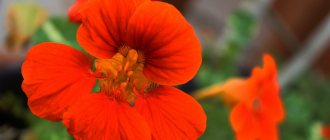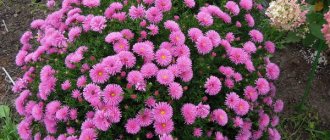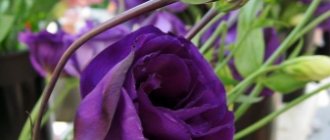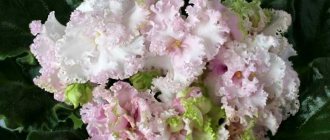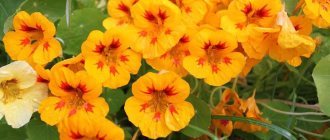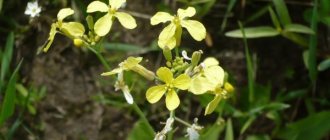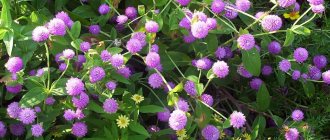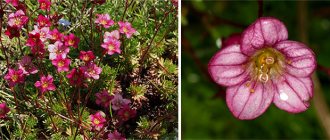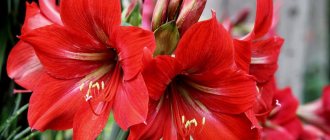What does a climbing nasturtium flower look like?
Nasturtium in the garden
Nasturtium is a flower that begins to bloom in early summer. There are a large number of plant varieties. But climbing nasturtium has common characteristics that distinguish the culture from other varieties.
Which family does it belong to?
Nasturtium flowers belong to the Capuchinaceae (Nasturtium) family. It can be a perennial or annual species depending on the variety. There are more than 80 plant varieties.
Briefly about the history of appearance
Bright flowers look great in any flower bed
The plant was first noticed in South America. Later, varieties of the crop spread to Central America. Gradually, the unusual flower became widespread in various countries, where it was called capuchin.
For reference! The seedling was brought to Russia from Holland. Due to its high ability to take root in any conditions, the plant has become popular.
Plant characteristics
Has the following characteristics:
- the vine forms side shoots, which leads to the weaving of large areas;
- suitable for landscaping gazebos, balconies and fences;
- the roots are located in the top layer of soil;
- buds are large yellow or orange;
- leaves are heart-shaped or small round.
The length of the vine can reach up to 4 meters with proper care. The crop can be grown using seeds or seedlings.
Useful properties of nasturtium
Nasturtium in a flowerbed can act not only as a decoration. The plant has a large number of beneficial properties.
The most famous include:
- bactericidal properties;
- vasodilation;
- anti-inflammatory properties (can be used to remove purulent formations);
- for the treatment of cough;
- treatment of skin for fungal diseases;
- restoration of the heart muscle;
- relief of menopause symptoms in women.
The plant has also gained great popularity in cosmetology. Using the plant extract, you can rejuvenate the skin and improve the condition of the hair.
Important! Nasturtium is not used for diseases of the digestive system. Also, if the juice of the culture gets on the mucous membranes of the eyes, inflammation may occur.
Beneficial features
Nasturtium is often used not only as an ornamental plant, but also as food; it has many beneficial properties. Almost all parts of nasturtium are edible except for the roots. Fresh shoots and young leaves can be added to salads, minced meats, soups and drinks. They add a piquant taste and, in addition, contain a large amount of vitamin C. Ground seeds can serve as a substitute for spicy seasonings for various dietary dishes. Nasturtium seeds produce an excellent edible oil that tastes like mustard.
A large number of different elements with healing properties have been identified in the stems, leaves and flowers of nasturtium. These are: ascorbic acid, carotene, tocopherol, phylloquinone, as well as iron and iodine. The juice contains various acids: stearic, oleic, palmitic, linolenic.
In folk medicine, it is successfully used to treat a number of diseases such as scurvy, atherosclerosis, angina pectoris, and metabolic disorders. It is considered an effective remedy for the treatment of vitamin deficiency, anemia and skin diseases. Nasturtium juice is used for burns. A decoction for the treatment of liver diseases, gout, anemia, rheumatism and diabetes. Nasturtium tincture is used as a hair growth stimulator.
In pharmaceuticals, the substance tropolein is used, extracted from nasturtium essential oils, which is used in the manufacture of drugs for the treatment of chronic coronary insufficiency.
In cosmetology, nasturtium has recently been used very widely. it is included in the composition of various ointments, creams, balms for various types of skin and hair.
We hope that after reading our review, you will appreciate this truly unique plant and soon these cute and useful plants will appear on your site that will decorate your dacha and, if necessary, can benefit your family.
Classification of popular types of nasturtiums
Types of ferns and their classification
Varieties of nasturtium have distinctive characteristics and are often used to create unique landscape compositions.
- Nasturtium foreign, or Canarian
A distinctive feature of the culture is the length of the vine, which can reach up to 4 meters. The liana is fleshy with a large number of side shoots.
Climbing nasturtium is used to decorate gazebos and slides. The leaves have a bright green color. A special feature of the plant is its small yellow buds.
Foreign nasturtium
- Large nasturtium
Large nasturtium is distinguished by its large size. Forms a bush that can reach a height of up to 1 meter.
The shoots are fleshy, but weak. The leaves are large green. Large buds can be terry or regular.
- Nasturtium cultivated
A hybrid plant, bushes can reach up to 50 cm in height. The leaves are round and large. Varieties of this variety can be compact in size or used for landscaping gazebos. The shoots are strong, densely decorated with leaves.
- Small nasturtium
Nasturtium minor is a small plant that is often found in gardens. The bush can reach up to 30 cm in height.
The leaves are small, heart-shaped. The buds are small yellow with small dark spots. The flowering period is from early summer until the first frost.
- Nasturtium shieldbearing
A shrub that has long shoots (up to 4 meters). The leaves are densely spaced and dark green in color. The buds are small and red.
Under natural conditions, nasturtium is a perennial plant. However, in many regions of Russia it cannot withstand frost. Therefore, the plant is regularly planted in the spring by using seeds or seedlings.
Important! The varieties of culture described above require undemanding care; they are immune to various types of diseases.
Varieties that are most popular with gardeners
Indian chrysanthemum - characteristics of varieties and cultivation from a mixture of seeds
Among the wide variety of plant varieties, it is necessary to highlight the most popular among gardeners.
- Alaska
Nasturtium Alaska is distinguished by a wide variety of bud colors. The height of the bush can reach up to 40 cm. The shoots are well developed with a large number of lateral branches.
Alaska variety
- Maiden Beauty
Nasturtium Maiden's Beauty is distinguished by a variety of colors. The buds are small in size, located on small side shoots.
- Canary
An annual climbing plant, the length of the vines can reach up to 3 meters. Small inflorescences are located on the side shoots.
Blooms bright yellow throughout the summer.
- Vesuvius
The plant grows to a height of no more than 26 cm. The stems are strong, erect, with a large number of lateral branches. The buds are orange in color with burgundy splashes.
Important! In order for the bush to maintain its compact size, it is necessary to timely tie up the shoots.
- Cherry Rose
The height of the plant is no more than 50 cm. The bush grows compactly. The flowers are large cherry color. Most often used to decorate balconies and window boxes.
Cherry Rose variety
- Black truffle
A low-growing crop, the height of which is no more than 30 cm. The leaves are carved green. The inflorescences are dark cherry in color and bloom until the end of October.
- Mahogany
The plant is small with erect shoots. The leaves are round and dark green. Terry buds are bright red.
- Mayskaya
Annual plant. Most often they crawl along the ground. The length of the stem can reach up to 1 meter. The buds are orange in color with bright red stripes.
May nasturtium
- Silk Road
The climbing plant has a thick stem, from which lateral shoots extend in large numbers. Inflorescences of different colors are located on high peduncles.
- Cherry rose
The unusual coloring of the plant makes it popular among gardeners. The height of the bushes is up to 30 cm. The buds are painted in a rich red color.
- Black Lady (Black Velvet)
The plant is distinguished by burgundy buds with yellow spots. The bush can reach a height of more than 40 cm.
- Moonlight
The crop grows in the form of vines reaching a length of up to 3 meters. Small buds are light yellow in color.
Variety Moonlight
- Golden Globe
The bush has the shape of a ball. Often used to create compositions.
The height of the bush can reach up to 40 cm. The leaves are large, shield-shaped. The buds are large, terry, golden in color.
- Gleming Mahagani
The bush is stable, the height can reach up to 40 cm. The inflorescences are densely located on the shoots. The bud is double, red.
- Ladybug
A compact plant, the height of which can reach up to 25 cm. The leaves are small, the branches are underdeveloped. A special feature of the buds is a delicate apricot color with dark spots.
- Salmon Baby
The liana can reach a length of up to 2 meters. Often used to decorate gazebos. Blooms in early summer, retains buds until the first frost. The flowers are salmon-colored.
Variety Salmon Baby
- Peach Melba
Nasturtium is low growing. The height of the bushes can reach up to 30 cm. The shoots are weak and spread along the ground. The leaves are round in shape and rich green in color. The buds can be yellow and orange.
- King Theodore
The height of the bush reaches 40 cm. The leaves are small and green. A distinctive feature is the terry red buds.
Important! The flowers of the plant contain large amounts of vitamin C. Therefore, the buds are often eaten as additions to salads.
Planting in flowerpots, flowerpots and pots
White peonies - description and characteristics of the best varieties with a colored center
Nasturtium grown in pots
Nasturtium planted in a flowerpot has an unusual appearance and allows you to create hanging compositions.
All types of crops can be used for cultivation. However, the most attractive are the low-growing varieties that do not form long vines.
Planting the crop with seeds is carried out at the end of May. To grow seedlings, seeds must be planted in pots a month before planting. Seedlings should be planted in open ground after the air has warmed up and there is no risk of frost.
Nasturtiums on the balcony are most often planted in box pots. With the help of the plant you can create a bright flower bed on the balcony. For private homes, the ideal solution would be to plant seeds in flowerpots installed along garden paths.
Sowing seeds
Nasturtiums are usually propagated and grown from seeds.
Weight, germination of seed
Nasturtium seeds are large and fleshy, so one flower will not produce too many seeds. In appearance, the seeds are somewhat reminiscent of peanuts - they are oval, slightly elongated, their surface is striped.
Seed color:
- unripe ones are pale green;
- Ripe seeds are brown and wrinkled.
You can collect the seeds yourself or buy them. They are quite heavy and large, so there are not many of them in one package. Immediately after purchasing seeds, check that they are healthy and dry.
Seed characteristics
| Weight 1000 seeds | 65-200 g |
| 1 g contains | 5-16 seeds |
| 1 flower contains | 1-3 seeds |
Seed germination depends on the species being grown:
- Nasturtium seeds (T. speciosum) are sown in the fall and left in a cool place to germinate after about a month;
- Grandiflora nasturtium (T. majus) and Canary Island nasturtium (T. peregrinum) can be sown in pots stored indoors or directly outdoors (only sow when night temperatures do not fall below 9°C).
Seed germination time:
- indoors - 10-20 days,
- outdoors for 2-3 weeks.
Collection and storage of seeds
These small plants produce seeds profusely. Many people wonder whether to collect green seeds or wait until they turn brown. There are several ways to collect, it all depends on how you intend to use the resulting seeds.
The seeds ripen irregularly from July to October. They will germinate within 4 years. Since the seeds tend to self-sow, material can be scattered around the plants on which they can be collected after they have fallen from the flowers. If the seeds are planned to be used for culinary purposes (as a substitute for capers), they are collected green. Because they are large and grow singly on stems, they are easy to harvest. Ripe seeds fall out without problems. The dried brown seeds are suitable for sowing to produce new flowers.
The collected seeds should be scattered and dried until completely dry. For amateur use, it is recommended to lay them out on paper or fabric. Once they have lost moisture, they can be placed in paper bags and labeled. Then the seeds should be placed in a dry, cool, ventilated area. Seeds can be stored for 4 years.
Sowing time
Nasturtium seeds are frost-resistant, but germinate very quickly. Therefore, they can be planted in open ground when there is no risk of frost, that is, in mid-May. However, late sowing will lead to a delay in flowering - flowers will appear only at the turn of July and August. To speed up flowering, seeds can be sown a little earlier under polyethylene.
Seeds can be sown earlier in the garden at home, but the plant does not like transplanting. Therefore, seedlings are grown in cups so that they are not damaged when planted in the ground.
Sometimes the flower propagates by self-sowing, and the next season it can be found in different parts of the site. Tuberous nasturtium is propagated in the spring by separating the tuberous shoots and planting them separately.
Sowing
- Seeds begin to germinate in 10-14 days. To speed up the germination process a little, soak the seeds for several hours in warm water before sowing.
- Nasturtium does not like competition, so it should be planted at a distance of 20-30 cm. For climbing varieties with many shoots, a greater distance should be maintained.
- When planting climbing varieties, be sure to provide supports or trellises on which the plant can grow. There is no need to tie up the shoots - the vines quickly wrap around the support.
- Don't sow the seeds too deep - the optimal depth is 1.5 cm. Darkness is necessary for growth and you should ensure that the seeds are not sown too shallow.
- Seedlings need moisture during germination, so water them regularly.
Features of care in the garden and on the balcony
For balconies, terry mixture of nasturtium is most often used. The flowers have bright colors. Care in the garden and on the balcony is no different. In order for the plant to bloom profusely, the following points must be observed:
- It is necessary to water the bushes daily. It is recommended to spray the bushes with water from a spray bottle in the evening.
- Loosen the soil regularly, especially if the plant is grown on a windowsill.
- Remove weeds in a timely manner.
- It is also recommended to remove faded buds and dried branches.
In order for the nasturtium in the pot to bloom profusely, it is recommended to regularly apply nitrogen and potassium fertilizers. For these purposes, ready-made mixtures are used, which must be dissolved in water and the bushes must be fed once a week.
Growing on the balcony
When growing a plant in the garden, a problem often arises when shoots spread along the ground. It is important to know how to tie climbing nasturtium:
- Supports for bushes are installed as soon as the first shoots appear. It is necessary to stretch the wire between the supports.
- After young shoots appear, it is necessary to straighten the vine, forming a beautiful fan.
- To strengthen the vine, you should not use a rope, since the side shoots quickly intertwine with each other, forming a solid canvas.
Often, several plant varieties are used to form such vertical flower beds.
Attention! In order for the flowerbed to bloom profusely throughout the summer, it is recommended to install automatic watering systems.
When and how does it bloom
During the flowering period, the culture attracts everyone's attention. You need to know how nasturtium blooms and what care rules must be followed during the formation of buds.
Flowers consist of 5 or less than 6 petals. Flowers may be double, semi-double or simple. The size of the buds depends on the variety, and can range from 2 to 8 cm in width.
The shape of the flowers is irregular and looks like a hood. At the base of the flower there is a small spur-shaped growth. The original name of the flower was capuchin, which matches the description of the flower.
Flower shape
The period when nasturtium blooms is from mid-June to October. If the seeds are sown at the end of May, the flowering period occurs at the beginning of July.
To extend the flowering period, it is necessary to increase watering before the formation of buds. However, after the first flowers appear, watering stops and is carried out no more than once a week.
The liquid is applied using the root method, so that drops of water do not fall on the buds. It is also necessary to stop fertilizing.
Possible problems in growing
If not cared for correctly, many gardeners wonder why the plant does not bloom. Such symptoms can appear for several reasons.
Pests
Thanks to its bright aroma, the plant is often used in the country to repel pests. However, in rare cases, parasites such as caterpillars may appear on the nasturtium itself. To combat them, it is necessary to pollinate the bushes with wood ash.
Pests of nasturtium
Diseases
Nasturtium has high immunity to diseases. However, in some cases the following problems may occur:
- bacterial wilt;
- spotting;
- gray rot.
When the first signs of the disease appear, the affected area is carefully trimmed.
Important! To prevent the plant from being exposed to diseases, it is necessary to soak the seeds in a light solution of manganese before planting.
Signs of improper care
If not properly cared for, the plant may not form inflorescences. The following factors may be the reasons:
- Use large amounts of water for irrigation. It is necessary to water the plant in small quantities so that the soil is moistened superficially. The accumulation of water leads to the appearance of rot in the root system.
- Use of fertilizers in large quantities. This is especially true for nitrogen-containing substances. Nitrogen provokes the appearance of green mass, but inflorescences will not form. Therefore, it is recommended to alternate different substances during feeding.
- Planting a plant in the shade. Nasturtium prefers sunny places, so planting near buildings and in the shade of trees is not recommended.
Caring for and growing crops in open ground is not difficult if you follow the recommendations of experienced gardeners.
Likes, doesn’t like – secrets of agricultural technology
Behind the unpretentiousness of a flower and the simplicity of its agricultural technology, as always, lies knowledge. About its origin, biological characteristics, vegetation cycle. Nasturtium also has secrets.
sun flower
She is light- and heat-loving, like a real native of the tropics. If you plant nasturtium in partial shade, it will “wrap itself up” in leaves and bloom much worse. To reach its full potential, it needs sun. A lot of sun.
It also needs “tropical” watering - infrequent, but plentiful, so that the soil is wet to the last root. During flowering, it is generally better not to rush with watering, wait for the soil to dry out, and then give a moisture-recharging dose.
The heat-loving nature of the flower is also manifested in the fear of the slightest frost. Never rush into sowing, let alone planting seedlings; wait for steady spring warmth.
More of a gourmet than a glutton
Installation - the more fertile the soil, the better, it does not work for nasturtium, and this must be the case when planting and caring for the plant.
On oily soil rich in humus, it drives away the foliage and blooms worse. There is no need to keep her from hand to mouth either, but it is better to feed her less often and with targeted “goodies” - mineral complex fertilizers for flowers. It is better to avoid manure, mullein, humus and other organic matter altogether.
Use in landscape design
Using nasturtium in landscape design
Nasturtium is used to decorate garden plots. It can be planted as an independent plant or as a landscape composition.
Nasturtium is often used to decorate gazebos and airy flower beds. The composition of different varieties of nasturtium against a background of greenery also looks attractive.
Nasturtium is divided into a large number of varieties and subspecies. It can be grown not only in the garden, but also on the balcony. The culture pleases with lush flowering throughout the summer. The plant also has a large number of beneficial properties and can even be eaten fresh.
Story
Perhaps there is no such person who, after watching the famous film “The Man from the Boulevard des Capuchins,” did not think, what are Capuchins? It turns out that this word has several completely different concepts. Well, firstly, the “Boulevard of the Capuchins” or more correctly “Boulevard of the Capuchins” is one of the Grand Boulevards of Paris, named after the monastery that was once located on this street, in which female nuns from the “Capucin Order” lived. This boulevard became most famous after the opening of the first cinema on it in 1895, which became the most active promoter of cinema, one of whose emissaries was the hero of Andrei Mironov. By the way, members of the Capuchin Order got their name because an indispensable attribute of the monks’ attire were pointed hoods, which in Italy are called Capuchins. This is what is now called a masquerade costume consisting of a cloak with a pointed hood. Another meaning of this word is the name of the prehensile-tailed monkeys of South America.
Well, the most famous meaning of the word “capuchin” is the name of a flower, which in Latin is called Tropaeolum. The second Latin name for this flower was given by the creator of the classification system, Swedish physiologist Carl Linnaeus. He noticed the similarity of the leaves of this plant with the shields of ancient Roman soldiers, and the flowers themselves seemed very similar to the bloody helmets of defeated enemies, which were hung on columns in Rome in honor of victory. These columns were called tropaeolum. This name was not particularly popular and in most countries, including ours, this flower is called nasturtium.
Not only did nasturtium receive such amazing names, it has a rather unique history, as a result of which botanists recognized it as an ornamental species and it began to decorate our gardens.
When, in the 16th century, after Columbus's discovery of America, the Spanish conquistadors got deep into this continent, they noticed that in the mountainous regions, in the territory of present-day Peru, Chile, Bolivia, and Evador, local Indians ate tubers of some plants. One of which turned out to be potatoes. Europeans liked it and soon this culture was brought to Europe, where over time it received universal recognition. But the second plant, the tubers of which were eaten by the locals, was not liked by the newcomers from the “Old World”. It was tuberous nasturtium or mashua in other words. This plant is still cultivated in the Peruvian Andes and is used both as food and as animal feed. In those places you can find several varieties of wild nasturtium. The most famous are: curly nasturtium, Fintelmann's nasturtium, short-umbrella nasturtium. But a plant similar to it, blooming with red and yellow flowers, interested Europeans not because of its edible qualities, but because of the beauty of the flowers. Naturally, some of the Spaniards brought seeds of previously unseen plants to their homeland. Over time, the seeds of these plants spread throughout Europe.
A resident of Seville, Dr. Nicholas Monard, became interested in unknown plants brought from the New World. He purchased seeds from sailors and merchants returning from America and sowed them in his garden. And when from seeds unknown to him a plant grew that tasted like watercress, popular at that time, he, by analogy, began to call it nasturtium, which was the name given to many spicy plants with a tart smell. In his monograph published in 1571, Nicholas Monard gave this American plant the name "nasturtium". And although plant taxonomists subsequently discovered that this American nasturtium and watercress are completely different plants, the name given by Nicholas Monard stuck with it forever.
In general, plants of the nasturtium family have several dozen species. These are mainly ornamental species, but these flowering plants are also edible. But their main advantage, of course, is the amazing shape of the flowers and the beautiful color scheme. In addition, nasturtium flowers have an amazing ability: when the sun sets, they seem to flare up from within and glow themselves. This was first noticed by the daughter of Carl Linnaeus, which he did not believe at first until he saw it himself. This is how Rachinsky, a professor at Moscow University, described this phenomenon: “At sunset in the bright orange western sky, the flowers, which shone bright orange in such lighting, from time to time suddenly flared up even brighter and at that moment seemed completely fiery.” Nasturtium became widely used as a decoration for gardens only in the 16th century.
